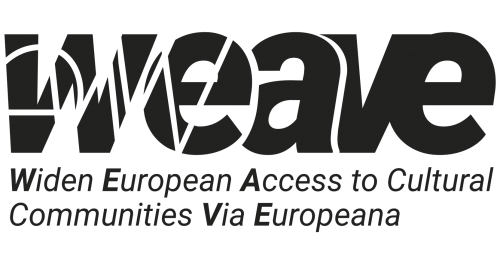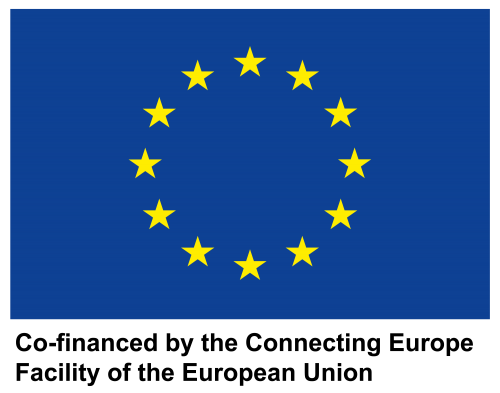11409
WEAVE – Widen European Access to cultural communities Via Europeana project aims to develop a framework to link the tangible and intangible heritage of cultural communities, safeguarding the rich and invaluable cultural heritage which they represent.
In particular, the project will aggregate over 5,000 new high-quality records to Europeana, and showcase these collections in a set of engaging editorials and a virtual exhibition. The project will carry out several capacity-building activities to develop a closer connection between cultural heritage institutions (CHIs), minority cultural communities and Europeana.
Additionally, WEAVE builds upon the results of CultureMoves and 50sKaleidoscope Generic Services Projects. It is developing open and reusable tools that will employ a mix of AI, machine learning, natural language processing, big data analysis, and innovative interface engineering. The toolkit will allow the management of annotations, semi-automatic recognition of specific gestures and movements and visualisation of performances and 3D models.
Furthermore, the project will demonstrate how the WEAVE Toolkit can be used by CHIs to better promote collections that would otherwise remain hidden, in educational and destination tourism contexts.
The consortium created for WEAVE is properly balanced and composed of partners with complementary expertise and well-aligned organisation priorities that match the objectives of the project and also understand Europeana, its principles and strategy.
The consortium perfectly covers the broad mix of stakeholders that are needed to successfully undertake such a project: cultural community representatives, content holders, innovative SMEs as technology providers, research organisations focused on ICT and scholars working in the area of cultural communities and heritage, complemented with an accredited Europeana aggregator and the Europeana Foundation.
Thus consortium partners span the entire value chain including partners with long-term expertise in the collection, preservation and curation of intangible cultural heritage and the heritage of cultural communities at risk, some of which also have academic relevance in the interpretation and consideration of the value of these resources in the landscape of European heritage.
As an added value, all the partners are included in wide networks of cultural heritage communities both locally and internationally, thus offering the opportunity to easily reach bigger and smaller cultural institutions for project awareness, dissemination and network-building.
Cultural communities’ engagement in the age of digital Cultural Heritage
Using and extending the participatory LabDay methodology developed by Coventy University (COVU) in the previous CultureMoves Action (2017-EU-IA-0171), this task is responsible for involving different cultural communities connecting them to CHIs and Europeana through virtual and physical events. At least one event will be organised by each of the partners representing one of the cultural communities involved in the Action (i.e. Roma community, traditional Portuguese dance and culture, historical dance community, daguerreotype photography community, Slovenian CH community).
ERIAC engaged with content contributors to provide valuable samples of Roma tangible and intangible heritage artefacts that will be included in the Europeana collection.
The items will be selected based on the following criteria
ERIAC members will be invited to propose items to be included while the final selection will be supervised by ERIAC management (with experience and expertise in curating). An emphasis will be placed on contemporary objects, especially examples of contemporary art produced by Roman artists, to counterbalance the dominant folkloric/ethnographic, and often a stereotypical representation of Roma people.
In the past there have been various exhibitions of Roma culture and contemporary art in the frame of Venice Biennales, namely in 2007, 2011 and 2019, which represent the greatest efforts ever made by Roma to present Roma art in an international stage in the center of contemporary cultural diplomacy. But in the lack of collecting, archiving and non-existent museum institutions to house artefacts, once these Roma exhibitions are dismantled, their histories become vulnerable and their achievements carry on only as interpersonal – and later transgenerational knowledge, which slowly – with the means of digital remembrance – constitute a new form of intangible cultural heritage. The Roma exhibitions are not connected to the prestigious locations, and known spaces of the Venice Biennale, but to the non-spaces of digital-discussions, oral histories, letter and in-person exchange, archival documents and digital exhibitions. Read more.
On November 5, the World Day of Romani Language, the European Roma Institute for Arts and Culture (ERIAC) organized the Second International Conference “Safeguarding Our Romani Language”, in partnership with the Council of Europe and the University of Graz.
The conference brought together experts, practitioners and legislators who participate in the protection and promotion of the Romani language. The aim of the event was to oversee the status of Romani, to discuss the issues of language preservation, the topic of transnational harmonization, as well as the practices in Romani language education.
ERIAC goal is to establish cooperation for language harmonization at an international level, to design future strategies for preserving the language heritage, and to fulfil the general need in Europe for Romani language education. This year we put special emphasis on the theme of heritage preservation involving digital tools. The conference was held online, providing a platform for international participants from various countries. Special significance will be given to the use of Romani during the event. Read more.
Since 2020, the joint programme of Villa Romana Florence and ERIAC has been the premier residency for artists of Roma descent. During our webinar, it was discussed the role of art residencies in advancing individual careers and the promotion of marginalised cultures. The cultural managers behind the trailblazing initiative, Angelika Stepken of Villa Romana and ERIAC’s Timea Junghaus were joined by the 2021 artists-in-residence L´uboš Kotlar and Norbert Oláh, to discuss the pros and cons of this kind of positive action targeting ethnicity in the field of arts and culture. Read more.
ERIAC aggregated for the first time content to Europeana from Roma about Roma. In fact, when navigating Europeana’s collections, Roma heritage and arts resulted under represented so far, thus determining a bias in the representativity of Europeana content as for the diversity of European cultures and communities. Some scanned documents and images in black and white existed, but these mostly featuring ethnographic content, and aggregated by traditional institutions without the involvement of a Roma community representation. Also, the lack of contemporary collections about Roma perpetuated the idea of Roma as passive elements of cultural and artistic contributions to history and society, thus not giving justice to the richness and vitality of this community and its heritage and creative values.
For this reason, in order to enrich the diversity of Europeana content and to foster better representation of the Roma community, ERIAC aggregated and published for WEAVE an exclusive collection of images and videos showcasing Roma-related exhibitions and artworks, and interesting materials sourced from conferences, symposiums, political events, concerts, lectures, projects where Roma artists, contributors, scholars, politicians and experts are also featured. An added value for the quality of this brilliant collection is the license of such copyrighted materials, that allows for reuse in educational context.
ERIAC used images of its own archive from exhibitions, events, concerts that were organized within the organisation. Additionally, Stiftung Kai Dikhas also collaborated by adding artworks’ images from their own collection, as well as artists such as Norbert Olah also contributed to aggregate their artworks to Europeana.
ERIAC collection in Europeana is visible here.
The overall amount of records for WEAVE: 298 items of which 47 videos and 251 images
Content quality level:
The project experimented with an exercise of co-curation on Roma heritage collections, jointly conducted by WEAVE partners TopFoto and ERIAC.
Digital collections of various types of heritage are an immense resource for knowledge sharing, and Europeana is the EU flagship initiative to make this common heritage accessible to any type of users. Europeana and its network of partners enable cultural heritage institutions to share their collections, that are composed of content (i.e. image, video, sound…) and descriptive information (i.e. the metadata): Europeana sets inclusive but also very specific standards for content and metadata quality, under the Europeana Publishing Framework, and Europeana Aggregators like Photoconsortium enable the technical process for publishing the collection (i.e. content + metadata) in the Europeana portal.
However, the responsibility of curation for the collection relies on the shoulders of the cultural heritage institution that preserves the collection. There are often cases where the collections contain contested heritage or heritage that depict minority/marginalized communities; and, especially in the case of very old collections, it is very likely that the original descriptions of the items, or that the items themselves (e.g. heritage colonial videos or photographs), include inappropriate terminology and offensive language towards the community that they intend to represent. While awareness is rising in the cultural heritage sector on the importance of a mindful approach in diversity and inclusion to make cultural heritage truly representative, not always the cultural heritage institution holding the content is fully aware of the problematic or insufficient metadata that are exposed; or may not have inside the full knowledge for appropriate curation or correction.
To provide a participatory approach in solving this problem, WEAVE experimented with an exercise of co-curation jointly conducted by partners TopFoto, one of the most renowned photographic agencies, and ERIAC, the European Roma Institute for Arts and Culture. Media experts in Roma heritage from ERIAC’s network were invited to review the collection about Roma heritage that TopFoto intended to provide for publication in Europeana. Read more.
This exhibition,curated by guest author Dr Adrian R Marsh and an afterword by Imogen Bright Moon, follows a discovery path from misrepresentation to renaissance of Romani arts and heritage, also exploring the histories of Roma communities and opening a window to their contemporary artistic expressions.
Dr Adrian Marsh was commissioned by ERIAC to be the writer and curator of the first exhibition about Roma written by Roma in Europeana editorials.
Access the exhibition here:
https://www.europeana.eu/en/exhibitions/the-renaissance-of-romani-re-presentation
The final WEAVE Conference took place on 17 September 2022 online and in presence in Girona, Spain.
The programme opened up with several keynote speakers, continued with presentations of the main project outcomes and of the effort in building the capacity of cultural heritage institutions for digital transformation and better engagement with communities.
This project is a Europeana Generic Services project, and it is co-financed by the Connecting Europe Facility of the European Union.


